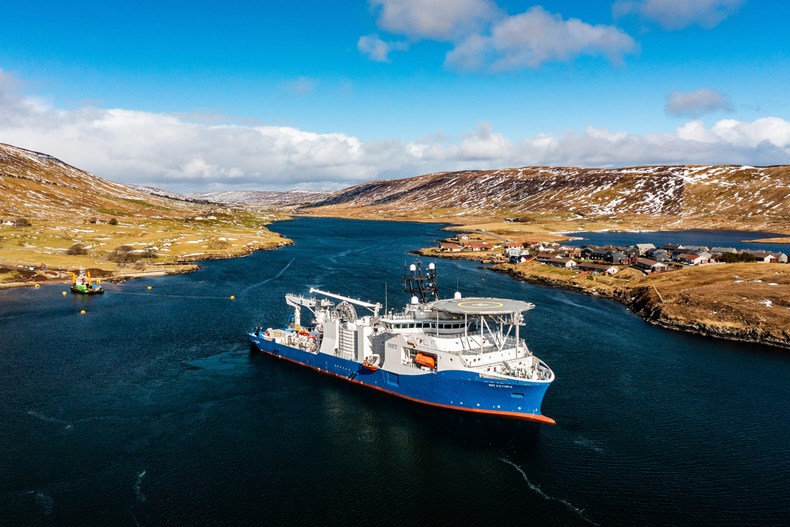
- Penultimate section of cable laying gets underway as NKT Victoria begins next journey from Weisdale Voe, Shetland
- Hugely significant and symbolic milestone with cable making landfall in Shetland
A significant milestone has been reached in connecting Shetland to the national electricity grid for the first time as the next section of subsea cable laying gets underway, helping secure the islands future security of supply of clean, low carbon power.
Waiting in waters off Weisdale Voe, specialist cable laying vessel the NKT Victoria and its expert team were readying themselves to start laying 60km of High Voltage Direct Current (HVDC) subsea cable system, bringing Shetland one step closer to being connected to the national grid for the first time. Once built, SSEN Transmission’s Shetland HVDC link will help secure the islands future security of supply of clean, low carbon power; alongside enabling the connection of new renewable electricity generation.
The NKT Victoria lowered the end of the cable which was then successfully pulled onto shore via previously installed ducts by a winch located on the shoreline at Weisdale. Once secured in the transition joint bay, the offshore cable will be jointed to the previously installed HVDC land cable which will then connect to SSEN Transmission’s Kergord HVDC converter station and AC substation.
The NKT Victoria will now make her way south out to sea along the designated cable route, slowly lowering around 60km of subsea HVDC cable system onto the seabed. Once the cable is in place on the seabed, it will be trenched into position using a multi-role construction support vessel with a specialist subsea jet trencher, which will ensure the cables are buried to the correct depth. Rock placement will also take place at some sections to ensure the cables are protected where trenching is not possible.
SSEN Transmission’s £660 million Shetland HVDC Link project involves installing a 260km subsea cable system between Noss Head in Caithness and Weisdale Voe in Shetland.
The project is split into three campaigns to allow for safe and accurate installation. The first 100km of cable was successfully installed in July last year, with NKT Victoria laying the cable from Noss Head in Caithness heading east and then northwards. The third and final campaign will take place later this year, which is 100km long and will complete the link between the first and second campaigns in the North Sea to join all three campaigns together and complete the full 260km subsea HVDC link.
SSEN Transmission’s Shetland HVDC Link Project Director John Scott said:
“The arrival of NKT Victoria in Shetland signals yet another major and hugely symbolic milestone in the Shetland HVDC Link project, and it’s been great to see the cable make landfall in Shetland as the vessel begins her voyage into the North Sea and kick off the next cable campaign.
“The installation of the subsea cable system is complex and requires significant planning to reach this point, and working with subsea cable experts NKT has enabled this process to take place reliably, safely and to the highest standard.
“The second cable campaign marks an exciting step in the project for SSEN Transmission and our contractors, and we look forward to the completion of this phase of the subsea cable campaign over the coming weeks.
"The Shetland HVDC Link is crucial to transporting clean, renewable energy to where it is needed most, ultimately helping us achieve a network for net zero; alongside securing Shetland’s future security of supply."
John Scott, HVDC Link Project Director
Claes Westerlind, Executive Vice President and Head of the NKT high-voltage factory in Karlskrona, Sweden, said:
“I am very satisfied that we continue the good collaboration with SSEN Transmission by leveraging our extensive experience within HVDC-technology to enable low-carbon power supply to Shetland.”
Shetland is currently an ‘islanded’ electricity network, with all electricity met from on-island sources, primarily the diesel powered Lerwick Power Station.
The link will enable 600MW of clean, renewable electricity generation to connect - including the 457MW Viking Energy Wind Farm, which upon completion is set to be the UK’s most productive onshore wind farm - supporting UK and Scottish net zero and energy security targets.
The Shetland HVDC Link project is on track to be completed by Summer 2024.


